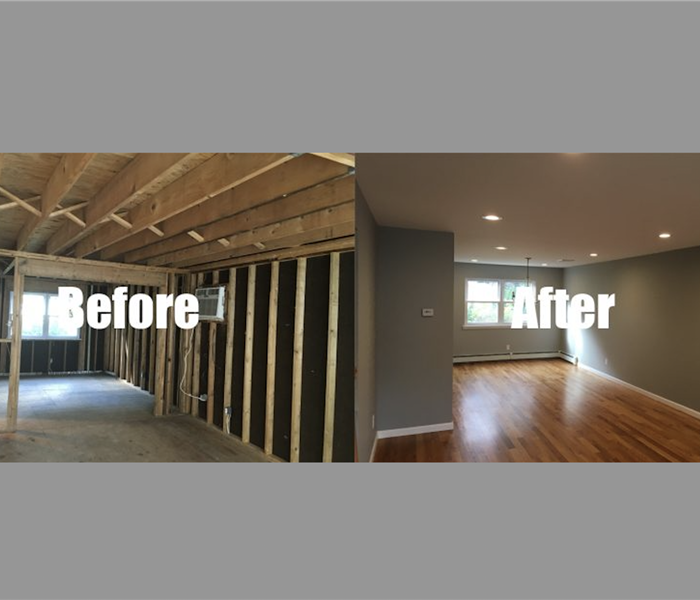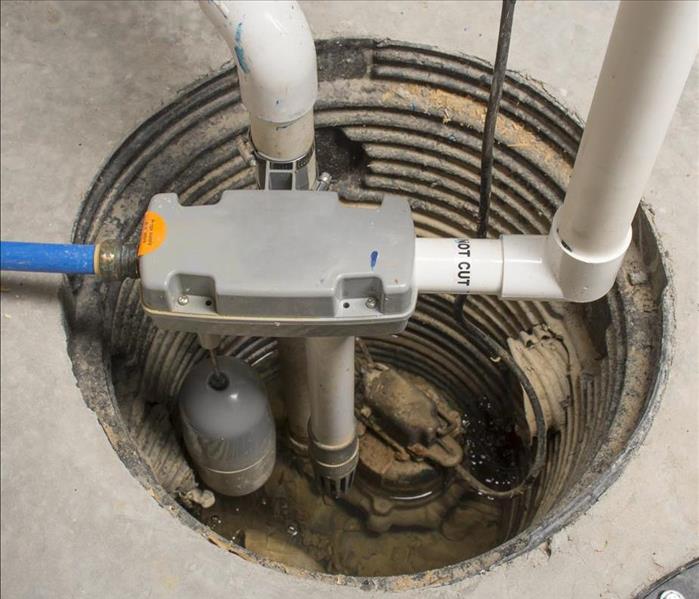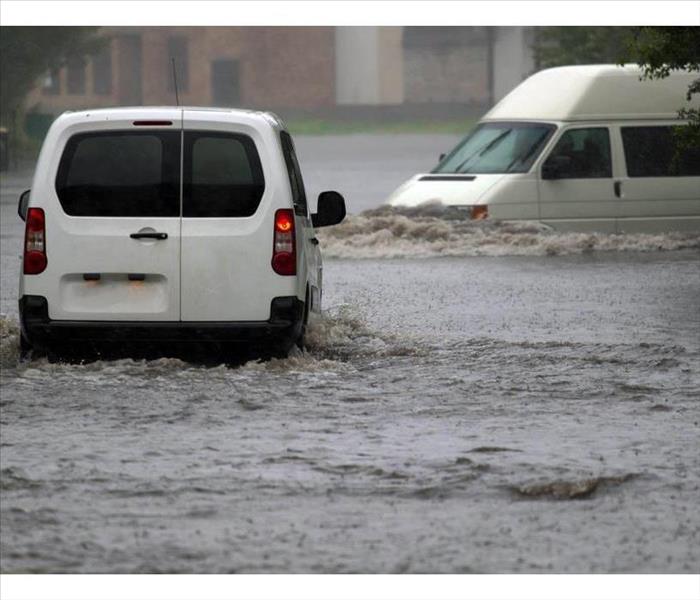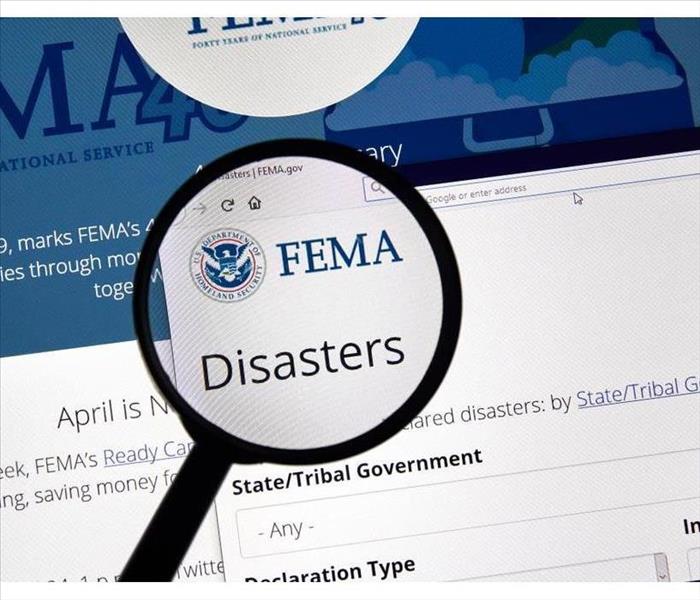Recent Storm Damage Posts
Understanding Flash Floods
1/17/2024 (Permalink)
 Flash floods are great examples of Mother Nature's fury.
Flash floods are great examples of Mother Nature's fury.
Flash floods are great examples of Mother Nature's fury, capable of causing significant damage within minutes. As experts specializing in water damage cleanup and restoration, we want to equip you with essential knowledge about flash floods and vital preparation measures in this article.
Understanding Flash Floods
Flash floods are abrupt, rapid floods that occur within six hours of heavy rainfall or other causative factors like dam breakage, landslide, or sudden drainage of water bodies in a typically dry area. They can roll boulders, uproot trees, destroy buildings, and carry away cars, swiftly altering the landscape.
Flash Flood Risk Factors
Topography, soil conditions, rainfall intensity, and duration are key risk factors. Urban areas are especially susceptible due to concrete surfaces and complex drainage systems.
Safety Tips for Flash Floods
Being adequately prepared and informed reduces risk during a flash flood dramatically. Here are some safety pointers:
- Stay Informed
Keep an eye on weather updates and flood alerts from local authorities.
- Know Your Area
Familiarize yourself with your local topography and flood zones. This knowledge will let you understand how quickly and severely you could be affected.
- Prepare an Emergency Kit
This kit should have essentials like water, food, medication, a flashlight, a battery-powered radio, and important documents.
- Avoid Floodwaters
Don't attempt to walk or drive through floodwaters. It's hard to estimate the depth or the current's power.
- Evacuation Planning
Plan evacuation routes that lead to higher ground. If authorities advise evacuation, do so immediately.
Flash Flood Cleanup and Restoration – Trust the SERVPRO® Experts
When a flash flood hits, the resultant water damage can be overwhelming. Acting swiftly is critical to minimize loss and ensure quicker restoration. That's where we come in.
Our team of experts at SERVPRO of Lake Conroe is ready to act fast with advanced equipment and techniques. We will expedite the water removal process, dry and clean the areas, restore items, and perform necessary repairs to bring your property back to its pre-flood condition.
Remember, understanding flash floods and the measures needed to safeguard against them can protect your property and save lives. Stay informed, stay prepared, and when the storm subsides, our SERVPRO® team is here to make it "Like it never even happened."
Protecting Your Business in Southern Texas Against Storm-Related Disruptions
9/26/2023 (Permalink)
Running a business in Southern Texas brings numerous opportunities, but it also comes with the responsibility of preparing for the region's unpredictable weather patterns. From hurricanes to heavy rainfall, storm-related disruptions can have a significant impact on your business operations. In this blog, we'll explore practical strategies to safeguard your business from storm-related disruptions, ensuring continuity and minimizing potential losses.
Understanding Southern Texas' Storm Challenges for Businesses
Southern Texas is susceptible to various storm-related challenges, including tropical storms, hurricanes, heavy rains, and flooding. These weather events can lead to power outages, property damage, supply chain interruptions, and more. Businesses need to be prepared to navigate these challenges and maintain operations even in the face of adverse weather.
Develop a Comprehensive Emergency Plan
Creating an emergency plan tailored to your business is essential. This plan should include protocols for evacuation, employee safety, communication, and business continuity. Assign roles and responsibilities to key employees to ensure a swift and coordinated response during storm-related disruptions.
Establish Remote Work Capabilities
Incorporate remote work capabilities into your business operations. Cloud-based systems and remote communication tools allow employees to work from home during storms or other disruptions. This flexibility can help your business continue functioning even if physical access to the office is limited.
Protect Data and Documents
Back up crucial business data and documents to secure cloud storage. In the event of property damage or power outages, this practice ensures that your business-critical information remains accessible. Consider having physical copies stored in a safe location as well.
Fortify Your Physical Location
If your business has a physical storefront or office, take steps to storm-proof the property. Install storm shutters or reinforce windows and doors to protect against wind and debris. Additionally, elevate electrical equipment and important machinery to prevent flood damage.
Maintain Communication Channels
Open and reliable communication is paramount during storm-related disruptions. Ensure you have multiple communication channels in place to reach employees, customers, and suppliers. Use social media, email, text messages, and other platforms to keep stakeholders informed.
Build Relationships with Suppliers
Establish strong relationships with your suppliers and vendors. Discuss contingency plans for supply chain disruptions caused by storms or other emergencies. Having alternative suppliers or backup plans in place can prevent delays in your business operations.
Invest in Business Interruption Insurance
Consider obtaining business interruption insurance that covers losses incurred due to storm-related disruptions. This insurance can provide financial support to help you recover lost income, cover ongoing expenses, and facilitate the resumption of normal business operations.
Protecting your business from storm-related disruptions in Southern Texas requires strategic planning and proactive measures. Developing an emergency plan, enabling remote work, safeguarding data, fortifying your physical location, maintaining communication channels, nurturing supplier relationships, and investing in business interruption insurance are all crucial steps. By implementing these strategies, your business can better weather the storms, ensuring continuity, and minimizing potential losses.
Tips for Sheltering in Place During a Hurricane
1/9/2023 (Permalink)
 Check your local TV stations for urgent updates on the storms status
Check your local TV stations for urgent updates on the storms status
Hurricane season is no time to mess around. A shelter-in-place hurricane plan can help you stay safe if you get caught in a storm. Here are some steps you can take to make sure your family is prepared for what's ahead:
Check and Charge Batteries
The first thing you should do is make sure your battery-powered devices are fully charged. This includes a battery-powered radio or television, phone charger and lantern, flashlight, and radio.
Have a Plan for Charging
Knowing what you can do to charge your devices before the hurricane hits is crucial. Have a plan for charging your devices as soon as it's safe to do so, and know where you can charge them.
If there is no power, have a backup plan for charging your devices in the event of an outage. You may need to use car batteries or generators to create a power source for these devices.
Make Sure You Can Receive Timely Alerts
There are several ways to get the latest news, alerts, and weather information during a hurricane:
Check your local radio stations for updates.
Check your local emergency alert system (EAS). Some areas use EAS to broadcast emergency messages, such as evacuation notices or shelter-in-place directions.
Check your local TV stations' websites and social media feeds for urgent updates on the storm's status and its impact on your area. You may also want to consider subscribing to email newsletters from these sources so you don't miss any important announcements when they're made.
Read the latest news online via online newspapers, which usually have dedicated hurricane coverage teams that work around the clock during major storms or natural disasters like floods or wildfires to bring their readers up-to-date information about what's happening with each one without having them constantly checking back every five minutes throughout those events just waiting for something new because nothing was happening before but now there is!
Stay Up To Date
In the event of a natural disaster, it's important to be prepared and stay informed. Listen to battery-powered radio or television for information on shelter locations, evacuation routes, and emergency relief efforts. You may lose power during the storm or have problems with your cell phone service after the storm passes.
If you have difficulty locating a new shelter location or don't know where you will go after your home is flooded, listen to local radio stations and check local news websites for updates.
Have Cash on Hand
If the storm is especially bad, you won't be able to rely on the ATM for your financial needs. Make sure you have some cash on hand before the storm hits in case there are no ATMs when things get back to normal again.
Cash will be necessary for buying food, water, and other supplies. It’s also helpful if you need to pay for emergency repairs or services after a natural disaster strikes—you can use cash as payment with local contractors while waiting for insurance companies to reimburse you later.
Seeking Shelter
If you are in a high-risk area and have time before the storm hits, identify one or more safe rooms in your home. The most important criterion for a safe room is that it is on the first floor and has no windows. If you have an interior stairway, it’s also ideal to include this as part of your sheltering plan—the top of the stairs should be well above flood levels if there is water damage to your house.
If you are in a two-story home, seek shelter on the lowest floor.
- Stay away from windows. If your house has a basement and/or storm cellar, move there quickly. If not, find a room with no windows or glass doors that can be closed.
- Check for loose objects such as lawn furniture or patio furniture that could fall on someone during high winds or falling debris. Also, look out for hanging pictures that may become dangerous projectiles if they break loose from their hooks on walls or ceilings (and don't forget to remove any valuable items).
- Find a room where you can get to the bathroom easily if necessary.
Be Prepared
The best way to prepare yourself is by learning what needs to happen before, during, and after the storm hits your area so that when the time comes you'll know exactly what steps need to be taken and how to do them.
We hope that these tips will help you prepare for the next hurricane. Remember to stay safe and give SERVPRO of Lake Conroe a call if your Conroe,TX home is hit by a hurricane.
4 Flood Safety Tips
9/2/2022 (Permalink)
 Prepare your basement.
Prepare your basement.
Flood Safety Tips
A flood is a common, yet destructive, natural disaster. When there is too much water for the ground to handle, it can rapidly accumulate, causing extensive property loss in a matter of hours. According to recent estimates, floods cost the United States almost $8 billion in damages every year.
Severe weather events are increasing in frequency worldwide, mostly due to climate change. Although the risk of flooding can’t be completely eliminated in Willis, TX, you can help keep your home and family safe by following these flood safety guidelines.
1. Rethink Your Home’s Wiring
Many electrical outlets are installed near the floor. This location isn’t ideal, especially if you own a house in a flood-prone area. To plan ahead for a water disaster, consider hiring an electrician to move your outlets above potential flood levels.
2. Reconsider Where Items Are Stored
You shouldn’t store treasured items in the basement. Even basements that are typically dry could flood if enough water accumulates. Instead, move valuable belongings to higher floors.
Flood safety experts recommend that when “soft” items like mattresses, upholstered furniture and stuffed animals get wet, they should be replaced. Keep this in mind when determining your storage arrangements.
3. Prepare Your Basement
Since flooding usually begins in the basement, give yours a fighting chance by waterproofing and installing a battery-operated sump pump. Despite your best efforts, if your basement were to flood, a water restoration specialist can help get your home back in order.
4. Teach Children About Flood Safety
Natural disasters are alarming, but being prepared can help. First and foremost, families should have a clear evacuation plan that is regularly reviewed with the kids in the household. It’s also important to have an emergency kit handy with things like flashlights, food, batteries and clean drinking water.
Floods can cause extensive damage and emotional stress. By following these flood safety tips, you can minimize the threat to your family and property.
4 Tips for Staying Safe During a Flood
7/12/2022 (Permalink)
 Do not travel through flood waters.
Do not travel through flood waters.
Stay Safe During a Flood
If you live in an area that often experiences severe weather and flooding, you should make flood safety a priority in your Conroe, TX home. Use the following tips to help keep you, your family and your home safe during a flood.
1. Make an Emergency Kit
Depending on the severity of the storm you are expecting, your emergency kit may vary from time to time. However, there are some items that should always be included, such as flashlights, radios and batteries in case the power goes out. Canned food and bottled water are good additions as well.
2. Have an Evacuation Plan
While an emergency kit can be helpful for less damaging storms, you need to know how to leave your home safely if the weather becomes a threat. Create a flood safety plan with your family that includes each member as well as any pets. Make sure to practice ahead of time so you are all familiar with the procedure.
3. Do Not Travel Through Flood Waters
If you do need to evacuate your home, only travel on roads that have not been flooded. Even if the waters look shallow, there may be road damage or debris lurking underneath. Depending on the speed and depth of the moving water, cars can be carried away resulting in a dangerous situation.
4. Have Your Home Cleaned As Soon As Possible
The need for flood safety does not end when the flood does. Flood waters can cause contamination and might make your family sick if it is not completely removed. If water from a flood has entered your home, it is a good idea to hire an emergency remediation service to help with cleanup as well as any necessary repairs. Throw away any food that has been in contact with the water.
It can be difficult to know what to do during an emergency situation. Keeping these safety tips in mind will be beneficial to you and your family the next time you find yourself expecting severe weather.
The Role of FEMA After a Storm
7/2/2022 (Permalink)
 FEMA is here to help families recover from disasters.
FEMA is here to help families recover from disasters.
FEMA's Role After a Storm
Powerful storms happen frequently in the U.S., from hurricanes that impact coastal areas to tornadoes that often hit the nation's Midwest to floods that damage homes along with major river systems. In nearly all of these situations, FEMA, the Federal Emergency Management Agency, is there to help families recover from disasters. The area has to be declared a federal emergency zone for the agency to provide assistance, where its role after a storm is to help citizens and emergency personnel respond to multiple challenges:
- Increase safety for all people
- Support the resources that lead to rescues
- Identify funds for recovery programs
The agency takes on a coordinating role, helping to manage the various parts of recovery. This includes a community of workers, lenders and businesses that make recovery possible.
An Effective Flood Response
When waters come into a home, the situation calls for an experienced water damage mitigation company located near the disaster in Cleveland, TX. This allows for a rapid response from highly-trained workers. The right company meets the criteria of FEMA for enacting a safe recovery by following established protocols. This includes water removal from the home, drying out of impacted materials and the restoration of damaged structures in the home. This response helps the individual family and the community recover from an overwhelming weather event.
A Comprehensive Approach to Flooding
Big disasters require the coming together of many different entities. The goal is to save lives, preserve property and help fund recovery, especially in situations where homeowners are uninsured or underinsured. Without this federal assistance, many families would face an uncertain future and might not have the resources to rebuild after a storm.
FEMA plays an important and often challenging role in keeping communities strong after a large disaster. By working with other parties, the agency looks to direct resources in the most effective manner possible.
Things to Avoid After a Flood
5/17/2022 (Permalink)
 Storm damage in Conroe, TX.
Storm damage in Conroe, TX.
The Aftermaths Of a Storm
If your home is flooded due to a storm in Conroe, TX, it needs to be taken care of as soon as possible to avoid further damage and mold growth. You should call a flood restoration team right away to deal with the floodwater. In the meantime, there are some things you should be aware of to keep yourself and your family safe.
Avoid Standing Water
Floods can occur when there are big storms with heavy rains and strong winds. These storms can cause power lines to fall, which can result in an electrical charge underground. Standing water may be electrically charged, so you should avoid areas that have standing water.
If you absolutely have to walk through standing water, always wear protective clothing, such as:
- Knee-high rubber boots
- Rubber gloves
- Protective overalls
Wearing these will help protect you against an electrical charge. You should also avoid touching any floodwater, as it can be contaminated with bacteria, chemicals and other pollutants.
Avoid Turning on electricity
Another way to avoid electrical accidents is to keep the electricity off if the storm caused the power to go out. Only turn it back on once the flood specialists tell you it is safe to do so.
Avoid Waiting too Long to Deal with a Flooded Home
You should start dealing with the flood water immediately to prevent further water damage. Mold can begin to grow in moist areas within 24 hours, so removing standing water and drying things out completely is imperative. The restoration team has pumps to quickly remove any standing water, and they also have powerful fans and dehumidifiers to dry things out fast.
Dealing with the aftermaths of a storm is not fun. Dealing with floods takes quick and thorough work to maintain the structure of your home and preserve as many personal items as possible.



 24/7 Emergency Service
24/7 Emergency Service





